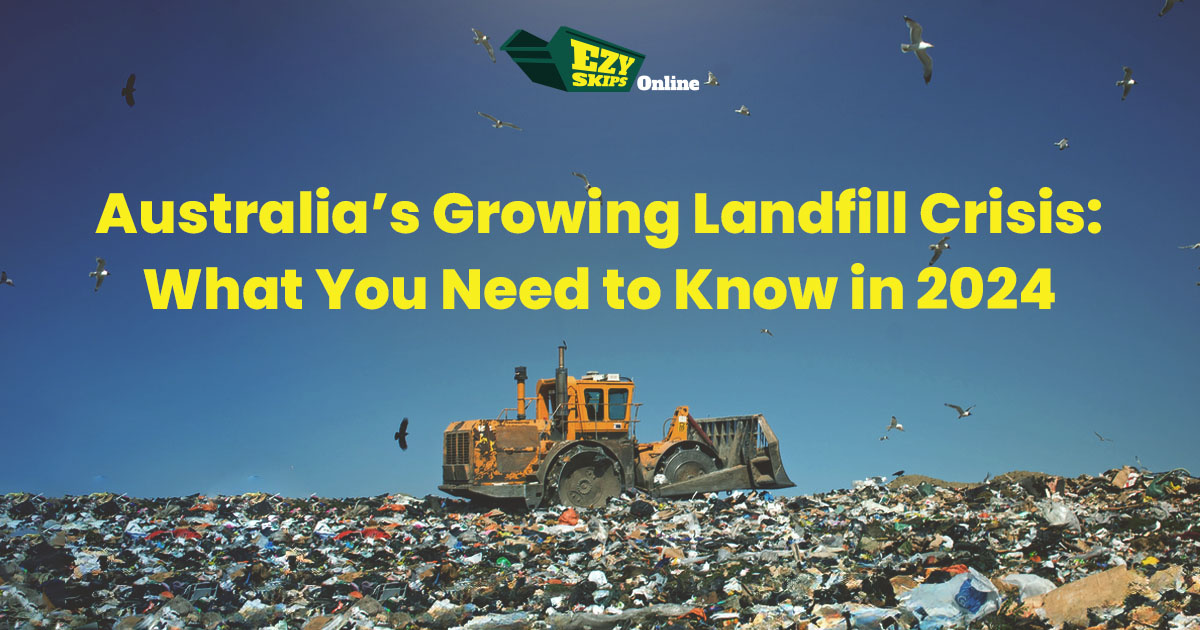
As Australia moves through 2024, it’s clear that landfill space is becoming a pressing issue. With waste generation increasing, many areas across the country are facing capacity constraints that could soon affect daily life, waste disposal, and even public health.
Here’s a breakdown of the current landfill situation and what’s being done to manage it across Australia.
Sydney’s Landfill Shortage
Sydney, one of Australia’s largest cities, is at the centre of a looming waste management crisis. Local experts predict that Sydney could run out of landfill space within city limits by 2028.
With fewer places to dispose of waste locally, more rubbish is being transported to regional landfills. This reliance on regional landfills has put extra strain on Sydney’s aging rail system, which is crucial for transporting waste out of the city.
In 2022, this transport system experienced a serious setback when flooding halted waste transport for ten days. With extreme weather events becoming more common due to climate change, Sydney’s waste infrastructure is vulnerable, and future disruptions could lead to piles of uncollected waste within city limits.
Updating transport systems and finding alternative solutions will be essential if Sydney is to maintain effective waste disposal as landfill capacity runs out.
Western Australia’s Long-Term Plan
Western Australia is taking steps to address its landfill needs through the State Waste Infrastructure Plan, which highlights that new or expanded landfills will be necessary to handle future waste and provide backup for emergencies. The current forecast suggests that by 2030, the state will face capacity constraints across over 144 landfill sites, with 37 million tonnes of waste at risk of not having adequate disposal options.
Planning for new landfills or expanding existing ones is a long process that requires early action. With approvals, construction, and operational setup often taking years, Western Australia’s authorities are urged to prepare well in advance to ensure future waste needs are met.
Lockyer Valley’s Solution to Limited Landfill Space
In Queensland’s Lockyer Valley, waste management planners are also looking to the future. The Gatton Landfill, one of the main sites in the region, is expected to reach capacity around 2032.
To deal with this, the Lockyer Valley Council is considering options like transporting waste to other regions or creating new landfill sites. Alongside these plans, the council is focused on improving recycling rates and introducing organic waste collection.
These initiatives aim to reduce the amount of waste sent to landfills, helping extend the lifespan of existing facilities.
How Much Waste Does Australia Produce?
In 2023, Australians generated about 75.8 million tonnes of waste, with construction and demolition waste being major contributors. While recycling rates have improved—up to 63% of waste is now recycled—there’s still a significant portion of landfill waste that could have been diverted.
The National Waste Policy Action Plan aims to increase the recovery rate to 80% by 2030, which means more waste will need to be recycled or reused rather than sent to landfill. To achieve this, Australia needs more recycling facilities, better waste management infrastructure, and stronger public engagement to reduce landfill dependency.
How You Can Help Reduce Landfill Waste
Addressing Australia’s landfill capacity issues requires a mix of government planning and community involvement. Here are some small but impactful ways you can help reduce landfill waste:
- Recycle Correctly
Make sure you’re aware of what can and cannot be recycled in your area. Many councils have resources to help residents recycle properly, reducing contamination that can limit recycling effectiveness. - Compost Organic Waste
Starting a compost bin at home is a great way to keep food scraps out of landfills. Many councils now offer green waste bins or organic waste collection services, which can also help divert waste. - Reduce Single-Use Items
Avoiding single-use plastics and choosing reusable alternatives can significantly cut down on waste that ends up in landfills. - Stay Informed and Engage
Pay attention to local council announcements on waste management, as they often provide tips and updates on new programs or changes that could affect your household waste practices.
The Path Forward
Australia’s landfill constraints highlight the urgent need for better waste management strategies. From Sydney’s waste transport challenges to the expanding demands in Western Australia and Queensland, solutions like improved recycling, organic waste diversion, and infrastructure planning are essential.
By taking a proactive approach, Australians can work together to reduce reliance on landfills and support a cleaner, more sustainable future. For instance, using a skip bin Kalamunda with Ezyskips Online is a great way to manage waste effectively; for more information on your council’s waste management initiatives or recycling programs, check local council websites and take advantage of community resources.
If you’re looking for personalised advice on waste management solutions, contact us for a free consultation—every bit helps in tackling Australia’s growing landfill problem.

